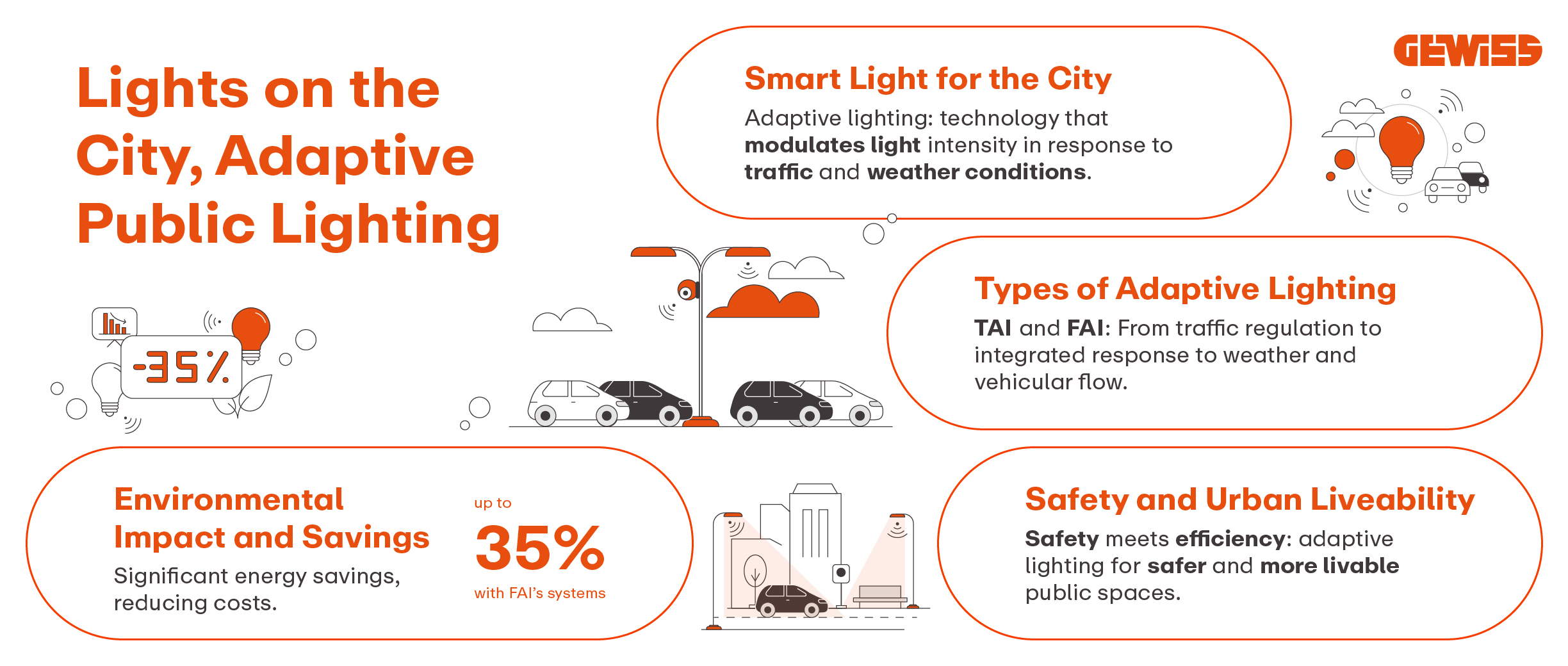
The efficiency and energy savings of adaptive public street lighting
Adaptive public street lighting creates street lighting and urban spaces capable of responding to the challenges of modern cities in terms of efficiency and safety, via a constant dialogue with the environment, traffic and atmospheric changes. Let’s discover the energy savings it offers to public administrations, how it changes the experience for the inhabitants of urban areas and the technological solutions that make it possible.
What is adaptive street lighting?
Adaptive lighting is an intelligent lighting system that aims to reduce waste with scientific precision and is one of several energy efficiency measures that brings enormous benefits in terms of liveability and savings to modern cities. This technology makes it possible to automatically vary the intensity of lighting in streets and public areas according to different conditions, such as weather, traffic and safety requirements.
The luminaries are equipped with sensors or cameras that analyse the context and send information to the system which determines the amount of light needed for each situation. The systems mainly fall into two types: TAI (Traffic Adaptive Installation) and FAI (Full Adaptive Installation).
The TAI system includes intelligent cameras that measure traffic flow for each lane and an algorithm that adjusts the lighting category accordingly. It is a simpler system, closer to that of traditional lighting: it overcomes the concept and the need for pre-set time slots but it is still tied to clear and well-defined lighting categories.
On the other hand, the FAI system detects the combination of weather, natural light and traffic. In addition to the traffic detectors of the TAI system, the luminaries are equipped with sensors that sample both the luminance of each lane and the meteorological conditions and respond to these in real time. Compared to the Traffic Adaptive System, the Full Adaptive System allows for a more complete picture of the environmental variables and faster, more precise response by the lighting system, due also to its capacity for gradual and continuous regulation rather than abrupt changes from one category to another.
The lighting devices in an adaptive lighting installation can be remotely controlled in two configurations: “point-to-point” to manage each lamppost individually or “island”, which remotely monitors the on/off panel.
The energy savings of adaptive public street lighting
Relamping public lighting with intelligent and modern technologies enables the best use of LED technology, including its dimming capabilities from 0% to 100%.
The full potential of LEDs, already less expensive in terms of consumed electricity, is exploited in adaptive lighting systems. Lighting intensity is constantly adjusted and optimised based on the environment’s variables, resulting in savings that may appear marginal at first glance but, multiplied by hundreds of cities and over the years, represent an important increase in energy efficiency.
In this regard, a study conducted on seven major roads by the Municipality of Perugia demonstrated appreciable savings in terms of weekly consumption. More precisely, 33-35% using an FAI system and 25-26% using a TAI system. Data that reveals the potential savings that LED and smart street lighting can provide in the long term.
Remote management panels also make it easier to ensure that actual savings are being made and to intervene promptly in the event of problems and faults that compromise efficiency. It is possible to visualise the status of the infrastructure, lighting points and sensors, control the adjustment of the systems according to traffic, and see the performance and sustainability indicators.
How public places are changed by adaptive lighting
As we mentioned, adaptive lighting constantly adjusts to each context it is implemented in. It is not just limited to reacting to traffic and weather but can also be configured to ensure the liveability and safety of public spaces and pedestrian traffic.
Pedestrian crossings, residential areas with heavy traffic, level crossings or roundabouts: adaptive lighting can be configured so the lighting in these areas remains at a maximum level, to prevent accidents and increase the attention of both pedestrians and drivers of vehicles.
Adaptive lighting has adjustable reaction times that are more or less rapid in the reduction or increase in light intensity and luminous flux according to the increase in traffic and the occurrence of potential hazardous situations. The ascent and descent are, however, gradual, to avoid abrupt changes that would compromise the liveability and comfort of the population.
Adaptive smart lighting systems are always open and implementable, so that systems already in operation can be expanded to include new urban areas. In this way, new suburbs, neighbourhoods, even individual streets and piazzas can be networked in response to the ever-changing needs of modern cities.
Adaptive lighting offers savings in energy terms, but it also adapts and responds to the social needs of modern cities, which are in continual evolution. Urban centres of all sizes are increasingly attentive to balancing energy efficiency and the needs of their inhabitants; adaptive lighting allows them to be more sustainable while also increasing safety in areas that would otherwise only be used during the day.
Trending Topics
Show other categories



























